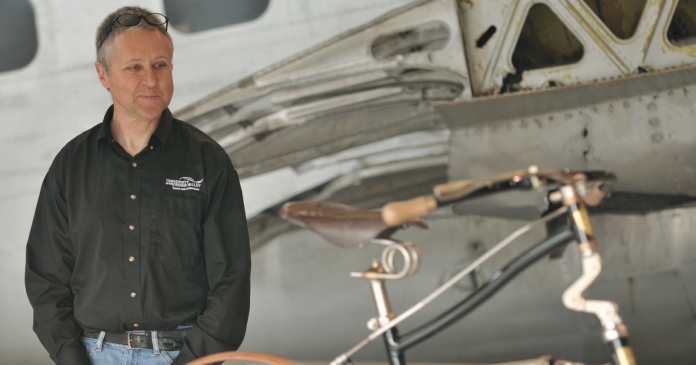Paul Brodie is a legend amongst cyclists worldwide. The creator of the high-end bike brand Brodie Bikes is an instructor at the University of the Fraser Valley, teaching a condensed bike frame building 101 class to a small group of eager students. Brodie recently released his new book Paul Brodie: The Man Behind Brodie Bikes, and I got a chance to interview the notorious guru about all things two-wheeled.
I drove to meet Paul Brodie in Fort Langley. It was early morning and the town was submerged in fog. We sat down outside of Lelem café with two brimming mugs of hot coffee:
I told my friend Tyler Klassen, who is an ex-pro mountain biker, I was coming to do an interview with you. He freaked out. He kept saying, “Brodie? From Brodie Bikes?”
Yeah, some people get quite excited.
You have been working with metal and bikes most of your life, for nearly 50 years, and now you’re teaching frame building 101 at UFV.
Yeah, the class’ six year anniversary is coming up this month. It’s been really great. They send me down to the NAHBB (North American Hand Built Bikes) show every year, and we’ve won that a few times, so we get publicity for my class through that.
What do you teach in your frame building 101 class?
Many students come to the class and have never held a torch. We begin by building a miniature frame, where students can learn how to use the tools and how to braze, file, tack, and weld.
So you start from the very basics.
Yeah, how to light a torch, how to adjust the flame.
I’ve seen work done by the students in your class. It’s incredible.
Once the paint goes on it looks like a pro frame. You can’t tell it’s the first frame they’ve built.
In the beginning of your book you tell a funny story about building your first mini bike.
I was 12 when I built that bike. The front wheel was from a wheelbarrow and the tubing was free pipe I found. My father borrowed a pipe bender from work and we bent it in the backyard. It didn’t have gears, and the brake pedal pushed a “spoon brake” against the back tire. It took four months to finish. I rode it a few blocks to the local gas station. I had to sneak down alleys — no licence, no insurance. I told the guy to “fill it up!” and he did. It took four cents, so I gave him a nickel and told him to keep the change. I didn’t know a lot when I was 12, but I had a lot of enthusiasm. You couldn’t stop me. It was always bicycles or motorcycles — anything two-wheeled
But you didn’t technically begin building frames until much later. You’ve worked many different jobs.
Yeah but I always loved bikes. I’m still a little crazy on a motorcycle. I had to go to Abbotsford a week ago. Coming back on Highway 1, I’ll admit, I was speeding. I took the 232 off-ramp, and there’s that roundabout, so I tucked in and leaned into the corner. I guess I got on the gas a little bit too hard because the rear wheel jumped out! I thought, “Right on!” If you don’t fall down then it’s OK, right?
Can you tell me about the early years of mountain biking in B.C.?
I was working in a bicycle shop (The Peddler in Vancouver), when the first Ritchie mountain bike showed up. That really impressed me. I wanted something like that, but I had no money. I often didn’t have money in those days. I went to the dumpster behind the building and pulled out an old 10-speed frame, took it home, cut it up. I didn’t know what I was doing, but I made my first mountain bike. That got me a gig at Rocky Mountain. Rocky Mountain was really skeptical when I offered to work for them — ***really skeptical. But they gave me 10 sets of mountain bike tubing and set me loose. A few weeks later I got the first bike frame assembled and brought it back to them, and they couldn’t believe it. I was like, “Well, what did you expect!?” That’s how it all started back in ‘83-‘84.
Were you ever afraid of failing?
When I start a big project, I don’t look at the whole picture of the project; it’s too daunting. I make a list, and each day I try and cross off one or two things from the list. I never quit. That’s how you get to be successful, you just have a list and every day you just try and do one thing, and then slowly it gets done. A lot of people give up on projects. So, just never give up.
That’s a great tip for students.
Well, sometimes you get setbacks. Sometimes you think you’re going one way, but something happens and you end up heading in a completely different direction. When I start something new, I tell everybody, “I’m starting this new venture.” It’s harder to back down and give up when you do that.
This interview has been edited for length and clarity


